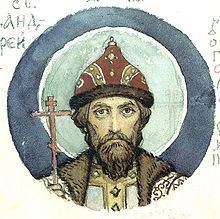Name Andrey Bogolyubsky Role Prince | Parents Yuri Dolgorukiy | |
 | ||
Venerated in Eastern Orthodox Church Major shrine Dormition cathedral, Vladimir Feast June 30, July 4 (burial) Attributes Clothed as a Russian Grand Prince, holding a three-bar cross in his right hand Died June 29, 1174, Bogolyubovo, Vladimir Oblast, Russia Children Yury Bogolyubsky, Mstislav Andreyevich Great-grandparents Vsevolod I of Kiev, Anastasia Similar People Yuri Dolgorukiy, Vsevolod the Big Nest, Vladimir II Monomakh, Ivan I of Moscow, Yaroslav the Wise | ||
Grandparents Vladimir II Monomakh | ||
Andrei I Yuryevich, commonly known under his sobriquet Andrei Bogolyubsky (Russian: Андрей Боголюбский, "Andrei the God-Loving") (c. 1111 – June 28, 1174), was Grand prince of Vladimir-Suzdal from 1157 till his death. His reign saw a complete decline of Kiev's rule over northeastern Rus, and the rise of Vladimir as the new capital city. Andrei was known in the West as Scythian Caesar, and is beatified as a saint in the Russian Orthodox Church.
Life
He was the son of Yuri Dolgoruki, who proclaimed Andrei a prince in Vyshhorod (near Kiev). His mother was a Polovtsian (Cuman) princess, khan Aepa's/Ayepa's daughter.
Andrei left Vyshhorod in 1155 and moved to Vladimir. Promoting development of feudal relations, he relied on a team and on Vladimir’s townspeople; he connected to trading-craft business of Rostov and Suzdal. After his father’s death (1157), he became Knyaz (prince) of Vladimir, Rostov and Suzdal.
Andrey Bogolyubsky tried to unite Rus' lands under his authority. From 1159 he persistently struggled for submission of Novgorod to his authority and conducted a complex military and diplomatic game in South Rus. In 1162, Andrey Bogolyubsky sent an embassy to Constantinople, lobbying for a separate metropolitan see in Vladimir. In 1169 his troops sacked Kiev, devastating it as never before. After plundering the city, stealing much religious artwork, which included the Byzantine "Mother of God" icon. Andrei appointed his brother Gleb as prince of Kiev, in an attempt to unify his lands with Kiev. Following his brother's death in 1171, Andrei became embroiled in a two-year war to maintain control over Kiev, which ended in his defeat.
Andrei achieved the right to receive a tribute from the population of the Northern Dvina land. Becoming "ruler of all Suzdal land", Andrei Bogolyubsky transferred his capital to Vladimir, strengthened it and constructed the magnificent Assumption Cathedral, the Church of the Intercession on the Nerl, and other churches and monasteries. Under his leadership Vladimir was much enlarged, and fortifications were built around the city.
At the same time the castle Bogolyubovo was built next to Vladimir, and was a favorite residence of his. In fact he received his nickname "Bogolyubsky" in honor of this place. It was he who brought the Theotokos of Vladimir to the city whose name it now bears. During Andrei Bogolyubsky’s reign Vladimir-Suzdal principality attained significant power and was the strongest among the Rus' principalities.
Amplification of princely authority and conflict with outstanding boyars was the cause of a plot against Andrei Bogolyubsky, as a result of which he was killed on the night of June 28 to June 29, 1174. Twenty of his disgruntled retainers burst into his chambers and slew Andrei in his bed. His silver-inlaid war axe can now be viewed at the State Historical Museum in Moscow.
His son, Yuri Bogolyubsky, was the first husband of Queen Tamar of Georgia. An ancient icon, Theotokos of Bogolyubovo, is associated with him.
